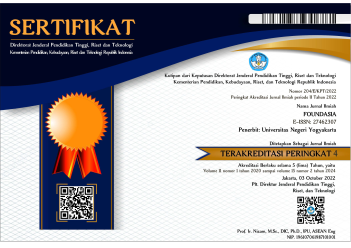Coping strategies for bullying: a phenomenology of student perceptions
Abstract
Efforts to reduce bullying in schools can be made by making strategies. However, so far, the strategies to overcome bullying are still seen from the teacher's point of view, and we need to see strategies to overcome bullying from students' perceptions. This study aims to find students' strategies for overcoming bullying. This research uses a qualitative approach with the type of phenomenology. The informants were high school and vocational high school students in Java. Data were collected through interviews, forum group discussions, and open-ended questionnaires. Data analysis used interactive analysis techniques. Data validity used triangulation of sources and techniques. The results showed that students' strategies to overcome bullying were carried out through social environment, internal factors, and external factors. The most effective strategies to overcome bullying are reporting to parents, teachers, or other students, being indifferent, establishing positive friendships, and focusing on the goals to be achieved. Supporting factors for the success of this strategy are the support system, guidance and counseling, and school socialization regarding anti-bullying. The inhibiting factors are school rules that still need to be firm, school culture that has not changed, and there is still an assumption that bullying is regular.
Keywords: strategies bullying, phenomenology, student perceptions
Full Text:
PDFReferences
Akrim, A., & Sulasmi, E. (2020). Student Perception of Cyberbullying in Social Media. Talent Development and Excellence, 12(1), 322–333. http://www.iratde.com
Al-Raqqad, H. K., Al-Bourini, E. S., Al Talahin, F. M., & Aranki, R. M. E. (2017). The Impact of School Bullying On Students' Academic Achievement from Teachers' Point of View. International Education Studies, 10(6), 44. https://doi.org/10.5539/ies.v10n6p44
Ansari, N. S., Elias, M. J., Greene, M. B., Green, S., Green, S., Greene, B., Michael, V. M., & Greene, B. (2018). Best practices to address (or reduce) bullying in schools. 97(2), 30–35.
Biswas, T., Scott, J. G., Munir, K., Thomas, H. J., Huda, M. M., Hasan, M. M., David de Vries, T., Baxter, J., & Mamun, A. A. (2020). Global variation in the prevalence of bullying victimization amongst adolescents: Role of peer and parental supports. EClinicalMedicine, p. 20, 100276. https://doi.org/10.1016/j.eclinm.2020.100276
Dwiningrum, S. I. A., Wahab, N. A., & Haryanto. (2020). Creative teaching strategy to reduce bullying in schools. International Journal of Learning, Teaching and Educational Research, 19(4), 343–355. https://doi.org/10.26803/ijlter.19.4.20
Efianingrum, A., Dwiningrum, S. I. A., & Nurhayati, R. (2021). Aktivitas sekolah yang rentan terjadi bullying di kalangan siswa. Foundasia, 12(1), 37–43. https://doi.org/10.21831/foundasia.v12i1.43465
Efianingrum, A. et al. l. (2020). Cyberbullying Pelajar SMA di Media Sosial: Pravalensi dan Rekomendasi. 8(Dec), 144–153.
Irvan Usman. (2015). Perilaku Bullying Ditinjau Dari Peran Kelompok Teman Sebaya Dan Iklim Sekolah Pada Siswa SMA Di Kota Gorontalo. 5(3), 248–253.
Källmén, H., & Hallgren, M. (2021). Bullying at school and mental health problems among adolescents: a repeated cross-sectional study. Child and Adolescent Psychiatry and Mental Health, 15(1), 1–7. https://doi.org/10.1186/s13034-021-00425-y
Kim, Y., Lee, E., & Lee, H. (2020). Erratum: Association between workplace bullying and burnout, professional quality of life, and turnover intention among clinical nurses (PLoS ONE (2019) 14:12 (e0226506) DOI: 10.1371/journal.pone.0226506). PLoS ONE, 15(1), 1–13. https://doi.org/10.1371/journal.pone.0228124
Koyanagi, A., Oh, H., Carvalho, A. F., Smith, L., Haro, J. M., Vancampfort, D., Stubbs, B., & DeVylder, J. E. (2019). Bullying Victimization and Suicide Attempt Among Adolescents Aged 12–15 Years From 48 Countries. Journal of the American Academy of Child and Adolescent Psychiatry, 58(9), 907-918.e4. https://doi.org/10.1016/j.jaac.2018.10.018
Levine, E., & Tamburrino, M. (2014). Bullying Among Young Children: Strategies for Prevention. Early Childhood Education Journal, 42(4), 271–278. https://doi.org/10.1007/s10643-013-0600-y
Ma’rufah, N., Rahmat, H. K., & Widana, I. D. K. K. (2020). Degradasi Moral Sebagai Dampak Kejahatan Siber Pada Generasi Millenial di Indonesia. Nusantara: Jurnal Ilmu Pengetahuan Sosial, 7(1), 191–201.
Mattew B. Miles, A. M. H. & J. S. (2014). Qualitative Data Analysis: A Methods Sourcebook.
Mu’ammar, M. N. (2017). Analisis Fenomenologi Terhadap Makna dan Realita Moh. 13, 120–135.
Nugrahani, F. (2014). Metode penelitian Kualitatif dalam Penelitian Pendidikan Bahasa. 305.
Nurhayati, R. (2022). Strategies to inculcate moral values in Islamic Elementary School. Research and Evaluation in Education, 8(1), 35–45. https://doi.org/10.21831/reid.v8i1.45041
Nurhayati, R., Irene Astuti Dwiningrum, S., & Efianingrum, A. (2020). School Policy for Bullying Prevention.
Nurhayati, R., Irene, S., Dwiningrum, A., & Efianingrum, A. (2021). School Policy Innovation To Reduce Bullying Effect. Al-Islah: Jurnal Pendidikan, 13(3), 2675–2688. https://doi.org/DOI: 10.35445/alishlah.v13i3.1235
Nurhayati, R., Suranto, S., Astuti Dwiningrum, S. I., Efianingrum, A., Herwin, H., & Haryanto, H. (2022). Principal component analysis on bullying measurement models in schools. Cypriot Journal of Educational Sciences, 17(8), 2771–2781. https://doi.org/10.18844/cjes.v17i8.7803
Rochma, H., & Nuryono, W. (2017). THE DEVELOPMENT OF A BULLYING PREVENTION SKILLS HANDBOOK FOR SENIOR HIGH SCHOOL STUDENTS. Jurnal BK Unesa, 7, 32–39.
Siswoyo, D., Rukiyati, R., & Hendrowibowo, L. (2020). Nilai-nilai dan metode pendidikan karakter di taman kanak-kanak di Banjarmasin. Foundasia, 11(1), 15–23. https://doi.org/10.21831/foundasia.v11i1.32485
DOI: https://doi.org/10.21831/foundasia.v15i1.73811
Refbacks
- There are currently no refbacks.

This work is licensed under a Creative Commons Attribution-ShareAlike 4.0 International License.










